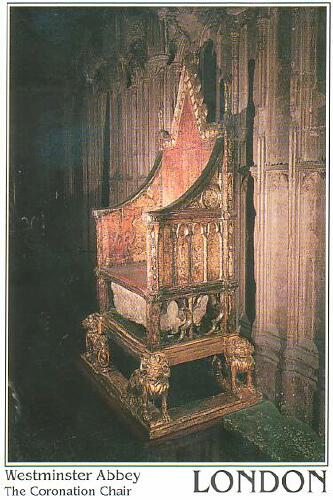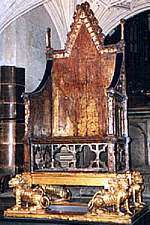 Coronation Chair with The Stone of
Scone......
Coronation Chair with The Stone of
Scone......The Coronation Chair was made for King Edward
I to enclose the famous Stone of Scone, which he brought from
Scotland to the Abbey in 1296, where he placed it in the care
of the Abbot of Westminster.
The King had a magnificent oaken chair made to contain the Stone
in 1300-l, painted by Master Walter and decorated with patterns
of birds, foliage and animals on a gilt ground.
The figure of a king, either Edward the Confessor or Edward I,
his feet resting on a lion, was painted on the back.
The four gilt lions below were made in 1727 to replace the originals,
which were themselves not added to the Chair until the early 16th
century.
The Stone was originally totally enclosed under the seat but over
the centuries the wooden decoration has been torn away from the
front.
At coronations the Chair with the Stone stands facing the High
Altar.
Every monarch has been crowned in this chair since Edward II in
1308, except Edward V and Edward VIII, who were not crowned.
At the joint coronation of William III and Mary II in 1689 a special
chair was made for Mary, which is now in the Abbey Museum.
The Chair was taken out of the Abbey when Oliver Cromwell was
installed upon it as Lord Protector in Westminster Hall.
It was used by Queen Victoria at the 1887 Golden Jubilee Services
in the Abbey.
During the Second World War the Chair was evacuated to Gloucester
Cathedral and the Stone was secretly buried in the Abbey.
Most of the graffiti on the back part of the Chair is the result
of Westminster schoolboys and visitors carving their names in
the 18th and 19th centuries.
The Chair was kept in the Chapel of St Edward the Confessor for
many centuries until that chapel was closed to general visitors
in 1997.
In February 1998 the Chair was moved out to the ambulatory and
raised on a modern pedestal and can now be viewed near the tomb
of Henry V.
Legends abound concerning the Stone of Scone
and tradition identifies it with the one upon which Jacob rested
his head at Bethel - "And Jacob rose up early in the morning,
and took the stone that he had put for his pillows, and set it
up for a pillar, and poured oil upon the top of it" (Genesis
chapter 28, verse 18).
The legend then says that Jacob's sons carried it to Egypt and
from thence it passed to Spain with King Gathelus, son of Cecrops,
the builder of Athens.
About 700 BC it was said to be in Ireland, whither it was carried
by the Spanish King's son Simon Brech, on his invasion of the
island.
There it was placed upon the sacred Hill of Tara, and called "Lia-Fail",
the "fatal" stone, or "stone of destiny",
for when the Irish kings were seated on it at coronations the
Stone groaned aloud if the claimant was of royal race but remained
silent if he was a pretender.
Fergus Mor MacEirc (died 50l?), the founder of the Scottish monarchy,
and one of the Blood Royal of Ireland, received it in Scotland,
and Kenneth MacAlpin (d.860) finally deposited it in the monastery
of Scone in Perthshire (846).
Setting aside the earlier myths it is certain that it had been
for centuries an object of veneration to the Scots.
Upon this Stone their kings, down to John Balliol in 1292, were
crowned, and it is said that the following words were once engraved
on the Stone by Kenneth:
The prophecy was fulfilled at the accession
of James VI of Scotland and I of England in 1603.
The Stone weighs 336 pounds and is composed of sandstone.
It was stolen by Scottish Nationalists on 25 December 1950.
After its recovery in April 1951 it was kept in the vault in which
it had been stored during the Second World War and was not replaced
in the Chair until February 1952, after elaborate precautions
had been taken for its future safety.
However, on July 3rd 1996 the Prime Minister (John Major) announced
that the Stone of Scone would be returned to Scotland by the end
of the year, returning to the Abbey for coronations.
On the evening of 13th November 1996 the Stone was removed from
the Chair by representatives of Historic Scotland and put in a
specially made crate.
It was transported by stretcher to stand in the Lantern of the
Abbey overnight and was removed in silence to the waiting police
escort early on the morning of 14th November to make the long
journey to Scotland by road.
It can now be seen in Edinburgh Castle.
So the Coronation Chair, once the oldest piece of furniture in
England still used for the purpose for which it was originally
built, now stands empty after 700 years.
 Coronation Chair with The Stone of
Scone......
Coronation Chair with The Stone of
Scone...... ......and without The Stone
......and without The Stone